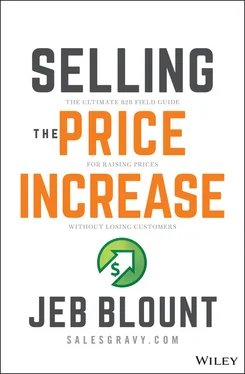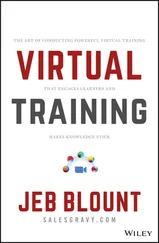Jeb Blount - Selling the Price Increase
Здесь есть возможность читать онлайн «Jeb Blount - Selling the Price Increase» — ознакомительный отрывок электронной книги совершенно бесплатно, а после прочтения отрывка купить полную версию. В некоторых случаях можно слушать аудио, скачать через торрент в формате fb2 и присутствует краткое содержание. Жанр: marketing, на английском языке. Описание произведения, (предисловие) а так же отзывы посетителей доступны на портале библиотеки ЛибКат.
- Название:Selling the Price Increase
- Автор:
- Жанр:
- Год:неизвестен
- ISBN:нет данных
- Рейтинг книги:5 / 5. Голосов: 1
-
Избранное:Добавить в избранное
- Отзывы:
-
Ваша оценка:
- 100
- 1
- 2
- 3
- 4
- 5
Selling the Price Increase: краткое содержание, описание и аннотация
Предлагаем к чтению аннотацию, описание, краткое содержание или предисловие (зависит от того, что написал сам автор книги «Selling the Price Increase»). Если вы не нашли необходимую информацию о книге — напишите в комментариях, мы постараемся отыскать её.
Selling the Price Increase: The Ultimate B2B Field Guide for Raising Prices Without Losing Customers
Selling the Price Increase
broad-based, targeted, non-negotiable, negotiable, defending, presenting,
asking
Virtual Selling
Selling the Price Increase
Selling the Price Increase — читать онлайн ознакомительный отрывок
Ниже представлен текст книги, разбитый по страницам. Система сохранения места последней прочитанной страницы, позволяет с удобством читать онлайн бесплатно книгу «Selling the Price Increase», без необходимости каждый раз заново искать на чём Вы остановились. Поставьте закладку, и сможете в любой момент перейти на страницу, на которой закончили чтение.
Интервал:
Закладка:
Through this progressive exposure to rejection, a mindset shift occurred. As he became immune to his greatest obstacle, he developed an emotional callus that made it harder for rejection to pierce his thickening skin.
Emotional discipline in the face of potential rejection is like a muscle. The more you exercise it, the stronger you become. Which is exactly why avoiding price increase conversations makes you weaker.
Data from research studies indicate that when your self-esteem and confidence is low, you become even more susceptible to rejection. 2 When insecurity consumes you, it is very, very difficult to be successful while selling price increases.
As Jiang progressed through his 100 days of rejection, he began getting improbable yeses. These wins boosted his self-esteem and his confidence, leading to more wins. In a virtuous loop, his confidence made it harder for people to say “no,” which in turn improved his probability of getting a yes, which made him even more relaxed, confident, and assertive.
Four Keys to Developing Price Increase Obstacle Immunity
Adversity is your most powerful and impactful coach. Things that challenge you change you—most often for the better. Here are the four keys to developing obstacle immunity when selling price increases:
1 Be ready and open to gaining resilience through the crucible of adversity and pain.
2 Intentionally choose to put yourself in uncomfortable, rejection-dense situations.
3 Actively seek out rejection by asking confidently for what you want.
4 Push through the early pain until you ignite your own virtuous loop of confidence.
Once you begin intentionally facing fears and emotionally uncomfortable situations, you'll learn to anticipate the anxiety that comes right before the obstacle. You'll learn how to shift your internal self-talk and outward physical reaction to that fear.
Soon, the emotional rigors of approaching customers with price increases cease to phase you and it becomes routine. In other words, the more you do it, the more confident and self-assured you become.
You'll gain a sense of mastery and confidence. This leads to higher self-esteem and improved effectiveness in price increase conversations.
Exercise 4.1 10 Days of Rejection
In this exercise, you will begin the process of mastering the fear-of-rejection obstacle. Each day for the next 10 days, you will approach another person and ask for something.
Log what you asked for “The Ask,” who you asked, where you asked, the outcome, and your emotions prior to asking, while you were asking, and after you asked.
Then, reflect on what you learned. Pay close attention to how responses to your asks change, as you gain more confidence.
Day One
The Ask:
Who You Asked:
Where You Asked:
The Outcome:
Log your emotional state before, during, and after you asked. What did you learn? What behaviors will you adjust before the next ask?
Day Two
The Ask:
Who You Asked:
Where You Asked:
The Outcome:
Log your emotional state before, during, and after you asked. What did you learn? What behaviors will you adjust before the next ask?
Day Three
The Ask:
Who You Asked:
Where You Asked:
The Outcome:
Log your emotional state before, during, and after you asked. What did you learn? What behaviors will you adjust before the next ask?
Day Four
The Ask:
Who You Asked:
Where You Asked:
The Outcome:
Log your emotional state before, during, and after you asked. What did you learn? What behaviors will you adjust before the next ask?
Day Five
The Ask:
Who You Asked:
Where You Asked:
The Outcome:
Log your emotional state before, during, and after you asked. What did you learn? What behaviors will you adjust before the next ask?
Day Six
The Ask:
Who You Asked:
Where You Asked:
The Outcome:
Log your emotional state before, during, and after you asked. What did you learn? What behaviors will you adjust before the next ask?
Day Seven
The Ask:
Who You Asked:
Where You Asked:
The Outcome:
Log your emotional state before, during, and after you asked. What did you learn? What behaviors will you adjust before the next ask?
Day Eight
The Ask:
Who You Asked:
Where You Asked:
The Outcome:
Log your emotional state before, during, and after you asked. What did you learn? What behaviors will you adjust before the next ask?
Day Nine
The Ask:
Who You Asked:
Where You Asked:
The Outcome:
Log your emotional state before, during, and after you asked. What did you learn? What behaviors will you adjust before the next ask?
Day Ten
The Ask:
Who You Asked:
Where You Asked:
The Outcome:
Log your emotional state before, during, and after you asked. What did you learn? What behaviors will you adjust before the next ask?
Challenge
Now that you've successfully completed 10 days of rejection, continue this exercise for the next 90 days until you have mastered this obstacle and become rejection proof.
Notes
1 1. Jia Jiang, Rejection Proof (New York: Harmony Books, 2015).
2 2. Amanda L. Chan, “This Is Why Rejection Hurts – and How to Cope with It,” Huffington Post (March 14, 2014). https://www.news.com.au/lifestyle/health/this-is-why-rejection-hurts--and-how-to-cope-with-it/news-story/b9847b1469a5e0703b00605e21ed860e.
5 Stop Worrying, Start Preparing
Mark Twain once said, “I've experienced many terrible things in my life, a few of which actually happened.”
From a purely evolutionary point of view, worry can be a good thing, because people who avoided danger in the first place were more likely to perpetuate their genes. But there is a big difference between avoiding something that might kill you and allowing worry about approaching customers for price increases to derail you.
Worrying about customer responses to price increases that have not yet happened is the genesis of unnecessary anxiety. When, in your mind, you see your customer yelling at you, canceling their orders and contracts, and rejecting you, it creates insecurity where it didn't previously exist, causing you to overthink, procrastinate, become paralyzed, or avoid approaching your customer with the price increase altogether.
Preparation and Practice
Preparing in advance of price increase conversations is a key to easing worry and maintaining emotional discipline. When it comes to these crucial conversations, winging it and leaving outcomes to chance is exceedingly stupid.
Savvy sales professionals build their plan and practice price increase conversations in advance. Planning allows you to:
Develop and practice messaging.
Build a business case.
Determine best- and worst-case outcomes.
Plan for questions or objections that may surface.
Consider fallback positions.
Set targets and limits when negotiating.
Review the list of stakeholders, step into their shoes, and consider their viewpoints.
Prepare to flex to stakeholder communication styles.
Anticipate and practice multiple scenarios.
Practicing and running through different scenarios is one of the keys to keeping your emotions in check and developing obstacle immunity for a specific price increase situation. Role-play scenarios with your manager or team members. Play out all the worst-case scenarios so you are prepared for any eventuality.
Читать дальшеИнтервал:
Закладка:
Похожие книги на «Selling the Price Increase»
Представляем Вашему вниманию похожие книги на «Selling the Price Increase» списком для выбора. Мы отобрали схожую по названию и смыслу литературу в надежде предоставить читателям больше вариантов отыскать новые, интересные, ещё непрочитанные произведения.
Обсуждение, отзывы о книге «Selling the Price Increase» и просто собственные мнения читателей. Оставьте ваши комментарии, напишите, что Вы думаете о произведении, его смысле или главных героях. Укажите что конкретно понравилось, а что нет, и почему Вы так считаете.












